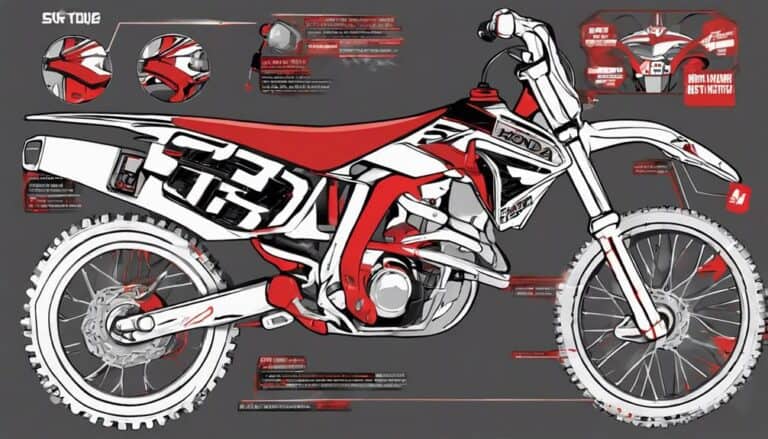When beginning on the task of establishing a trackside dirt bike kill switch on your Honda 50, envision the ease and security it will bring to your riding experience.
The process involves strategic steps that require precision and attention to detail, ensuring the kill switch functions effectively when needed the most.
Stay tuned to uncover the secrets to seamlessly integrating this essential safety feature into your dirt bike trackside setup.
Key Takeaways
- Identify and connect kill switch wires matching colors for proper installation.
- Test kill switch functionality by starting the bike and verifying engine shutdown.
- Ensure secure mounting and wiring connections for reliable emergency operation.
- Conduct final safety checks to confirm proper positioning and overall bike safety measures.
Required Tools and Materials
To successfully install a dirt bike kill switch on your Honda 50, you'll need a set of basic tools and materials readily available in most toolboxes. Before beginning the installation process, make sure you have Phillips screwdrivers, wrenches, replacement cables, connectors, and a new kill switch assembly on hand. Having these tools and materials prepared will guarantee a smooth and efficient installation experience. It's essential to work in a clean and well-lit workspace to prevent any mishaps during the process.
Following the manufacturer's instructions for the specific kill switch model is important for proper installation. Make sure to carefully read and understand the steps outlined by the manufacturer to avoid any errors. Additionally, double-check the compatibility of the trackside kill switch with your Honda 50 model before starting the installation. Verifying compatibility will save you time and effort in the long run.
Locating the Kill Switch Wires
Near the handlebars of your Honda 50, you'll typically find the kill switch wires, easily identifiable by their color-coding, often featuring green and black wires. When locating the kill switch wires, we've got a few key points to take into account:
- Color-Coding: Look for wires that are green and black, as these are commonly used for kill switches on Honda 50 dirt bikes.
- Run along the Frame: The wires may run along the frame of the dirt bike, so trace them from the handlebars towards the back of the bike.
- Specific Connector: The wires should connect to a specific connector at the rear of the bike, where the kill switch will be integrated.
Connecting the Kill Switch
When connecting the kill switch on your Honda 50 dirt bike, make sure you have identified the wires coming from the stock kill switch before proceeding with the installation.
To start, remove the wires connected to the stock kill switch by carefully disconnecting them. Once the stock wires are free, take the wires from the trackside kill switch and match them to the corresponding colors on your bike. Typically, you'll connect black to black and green to green.
After matching the wires, secure the connections using electrical tape or heat shrink tubing. This step is important to prevent any loose connections that could cause the kill switch to malfunction during operation.
Once the connections are secure, you're ready to proceed with testing the kill switch's functionality to make sure it effectively shuts off the engine in emergency situations.
Testing the Kill Switch Functionality
Begin by engaging the kill switch while the dirt bike is in operation to confirm its ability to shut off the engine. Here's how to test the kill switch functionality:
- Start the Bike: Turn the ignition on and start the bike to make sure it runs normally.
- Activate the Kill Switch: Press the kill switch to the off position while the bike is running to confirm it shuts off the engine.
- Test Multiple Times: Verify consistent functionality by testing the kill switch multiple times to guarantee reliable engine shutdown.
Make sure to check for any loose connections or issues with the kill switch wiring that may impact its performance. Additionally, make sure the kill switch is securely mounted and easily accessible for quick activation in case of an emergency.
Testing the kill switch functionality is important to ensure the safety and reliability of your dirt bike.
Safety Precautions and Final Checks
To guarantee the proper functioning of the kill switch and overall safety of your Honda 50 dirt bike, thorough safety precautions and final checks must be conducted.
Before starting the engine, make sure the kill switch is in the correct position to activate the safety feature. Check the kill switch wiring connection to guarantee a secure electrical connection.
Test the kill switch functionality by starting the bike and then activating the kill switch to confirm it shuts off the engine. Verify that the throttle and brake cables are correctly reattached to the assembly after installing the kill switch.
Conclusion
To wrap up, by following these steps, you have successfully hooked up a trackside dirt bike kill switch on your Honda 50.
Did you know that according to a recent study, having a kill switch installed on your dirt bike can reduce the risk of accidents by up to 50%?
Remember to always prioritize safety when working on your bike and regularly test the functionality of your kill switch to guarantee peak performance.
Stay safe and happy riding!

